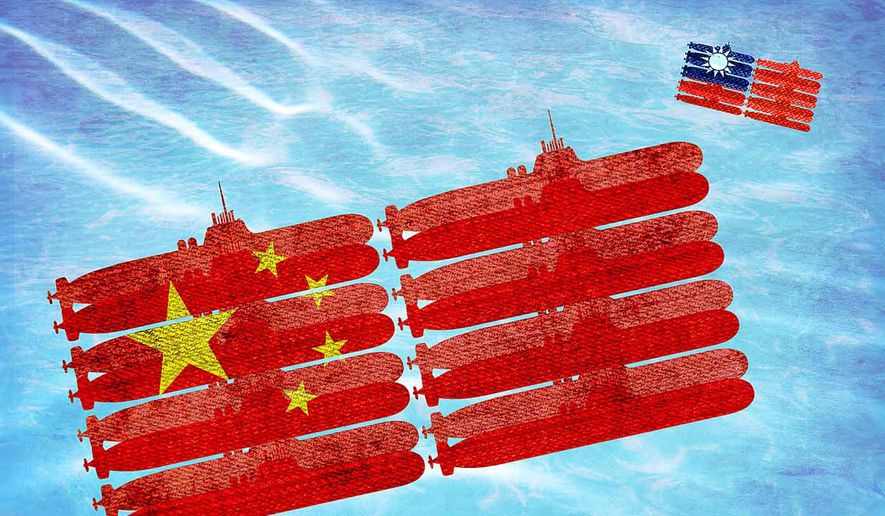OPINION:
To meet its long-standing requirements for modern submarines to deter attack from China, Taiwan has decided to start an indigenous development and construction program, which the United States can and should support.
Taiwan currently has four diesel-powered submarines used mainly for anti-submarine warfare training and limited combat missions. Two are ancient World War II-era, U.S.-built Guppy-class subs, one of which this author toured in 1996. It is a heart-rending experience for anyone who understands that in combat, its Taiwanese crew would be condemned.
In addition, Taiwan has two Dutch-designed and built Sea Dragon-class subs acquired in the mid-1980s. A modified version of this design is but one option Taiwan is considering for an initial four-submarine construction program that would run from 2020 to 2035. Four more may follow.
Taiwan’s indigenous program follows one started by former President George W. Bush in April 2001 to provide Taiwan with eight new submarines, sold through normal U.S. foreign military sales channels. However, the United States had not built diesel-powered subs since the early 1960s. Complications over acquiring a design, possibly from Europe, plus political-budgetary complications in Taipei, scuppered this laudable effort which, according to U.S. sources, almost succeeded.
Adding insult to injury, it took China only five years — 2001 to 2006 — to acquire eight new Kilo 636M-class submarines from Russia. Armed with the deadly supersonic Novator Club anti-ship missile system, these submarines pose a significant threat to Taiwanese, U.S. and allied naval forces.
Taiwan has the technical design and construction skills to build its own submarines and has structured its program to enhance domestic support. However, Taiwan would like help acquiring additional design consulting and sub-systems from the United States or potential European suppliers. This would include possible purchase of items such as combat systems, sonar systems, periscopes and weapons.
By any consideration, Taiwan seeks a modest submarine fleet to provide a deterrent force. It is not meant to go sub-to-sub with the 65 to 73 diesel- and nuclear-powered subs China may have by 2020, according the most recent annual report of the U.S.-China Economic and Security Review Commission.
Still, four to eight submarines could complicate China’s real goal of amassing an amphibious army force sufficient to invade Taiwan. China’s invasion plans envision using up to 12 new, large naval amphibious-assault ships, and scores of new, very large civilian roll-on, roll-off ferry ships. Taiwan’s submarines could effectively threaten these ships and force China to reconsider future invasion plans.
Providing Taiwan with the means to deter Chinese attack and to buy sufficient time to achieve a mutually acceptable peace with China has been a goal of U.S. policy toward Taiwan since the early 1950s. Unfortunately, this could take some time, for as long as the Communist Party-led government in Beijing remains in power, it is unlikely to agree to any peace that allows Taiwan’s vibrant democracy to thrive. Over in Hong Kong, Beijing’s efforts to suppress the “umbrella” movement for democracy offers a stark warning to Taiwanese and the world of the Communist Party’s abject fear of democracy.
Supporting Taiwan’s ability to defend its freedom, consistent with the 1979 Taiwan Relations Act, also advances immediate U.S. interests in opposing Chinese aggression and defending a maritime balance of power favorable to the United States and its Asian allies. Over the long term, the continued survival of a democratic Taiwan will offer hope to future “umbrella” reformers in China that they, too, can enjoy the political and economic freedoms Taiwan does today.
Conversely, a Communist Chinese conquest of Taiwan would end its democratic era and greatly diminish Chinese hopes for the same. Also, China could quickly turn Taiwan into a military base for missile, air and naval forces that would threaten U.S. allies Japan, South Korea and the Philippines.
While it has sold some new weapons to Taiwan, the Obama administration has declined to sell others, such as new F-16 fighters, in part because that might anger China. Nevertheless, the administration for two years has advocated finding Taiwan appropriate “asymmetric” weapons to offset China’s growing conventional military superiority. Helping Taiwan to achieve indigenous production of submarines would be consistent with this goal.
Richard D. Fisher Jr. is a senior fellow with the International Assessment and Strategy Center.




Please read our comment policy before commenting.